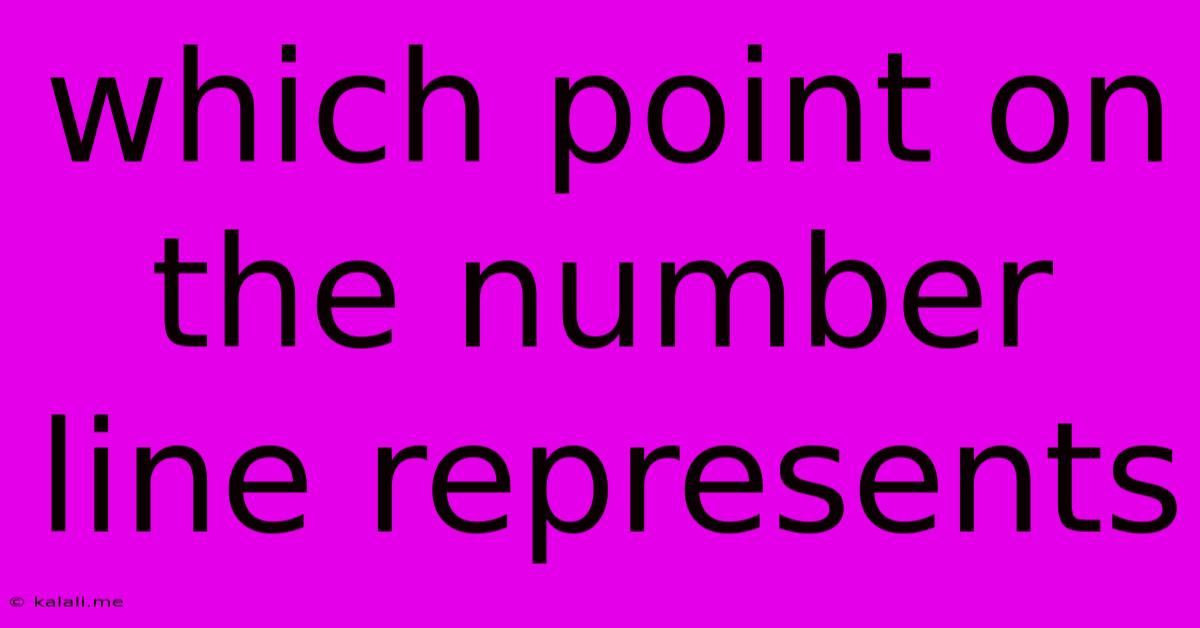Which Point On The Number Line Represents
Kalali
May 10, 2025 · 3 min read

Table of Contents
Which Point on the Number Line Represents? A Comprehensive Guide
Meta Description: Learn how to identify the point on a number line that represents a given number, covering integers, fractions, decimals, and negative numbers. This guide provides clear explanations and examples to master this fundamental math skill.
Understanding how to represent numbers on a number line is a fundamental skill in mathematics. A number line is a visual representation of numbers, extending infinitely in both positive and negative directions. This article will guide you through identifying the point on a number line that corresponds to a given number, regardless of whether it's an integer, fraction, decimal, or negative number.
Understanding the Number Line
The number line is a straight line with a marked zero point (0) at its center. Positive numbers are represented to the right of zero, and negative numbers to the left. The distance between each consecutive whole number (integer) is typically the same, representing a consistent unit of measurement.
Key Features:
- Zero (0): The central point, separating positive and negative numbers.
- Positive Numbers: Located to the right of zero.
- Negative Numbers: Located to the left of zero.
- Equal Intervals: The distance between consecutive numbers remains constant.
Identifying Points on the Number Line: Examples
Let's explore various scenarios to understand how to pinpoint numbers on a number line:
1. Integers:
Identifying integers (whole numbers) on a number line is straightforward. For example, the point representing the integer 3 would be located three units to the right of zero. Similarly, -2 would be two units to the left of zero.
2. Fractions:
Representing fractions on a number line requires dividing the intervals between integers. For instance, to locate 1/2, you would divide the interval between 0 and 1 into two equal parts. The point representing 1/2 would be located at the midpoint of this interval. Similarly, 3/4 would be located three-quarters of the way between 0 and 1.
3. Decimals:
Decimals are handled similarly to fractions. To locate 0.75 on a number line, consider it as equivalent to 3/4 and follow the same procedure as described above. For a decimal like 2.5, you would locate the midpoint between 2 and 3.
4. Negative Numbers:
Negative numbers are positioned to the left of zero. The principles for locating fractions and decimals remain the same. For example, -1.5 would be positioned midway between -1 and -2.
5. Comparing Numbers:
The number line allows for easy comparison of numbers. The number further to the right is always greater. For example, 3 is greater than 2, and -1 is greater than -3.
Practice Exercises
To solidify your understanding, try locating these points on a number line:
- 4
- -2.5
- 2/3
- -1/4
- 1.75
Tips for Success
- Draw a clear number line: Ensure the intervals are clearly marked and consistently spaced.
- Visualize the number: Before placing the point, imagine the number's position relative to zero.
- Break down complex numbers: For fractions and decimals, convert them to their simplest form for easier visualization.
- Practice regularly: The more you practice, the more comfortable you'll become with locating points on a number line.
Mastering the skill of representing numbers on a number line is crucial for building a strong foundation in mathematics. Understanding this concept unlocks further exploration of more complex mathematical ideas and provides a visual tool for understanding numerical relationships.
Latest Posts
Latest Posts
-
How Many Tenths Are In An Inch
Jul 15, 2025
-
Which Word Has The Most Positive Connotation
Jul 15, 2025
-
How Do I Send An Evite Reminder
Jul 15, 2025
-
When Performing A Self Rescue When Should You Swim To Shore
Jul 15, 2025
-
How Many Decaliters Are In A Liter
Jul 15, 2025
Related Post
Thank you for visiting our website which covers about Which Point On The Number Line Represents . We hope the information provided has been useful to you. Feel free to contact us if you have any questions or need further assistance. See you next time and don't miss to bookmark.